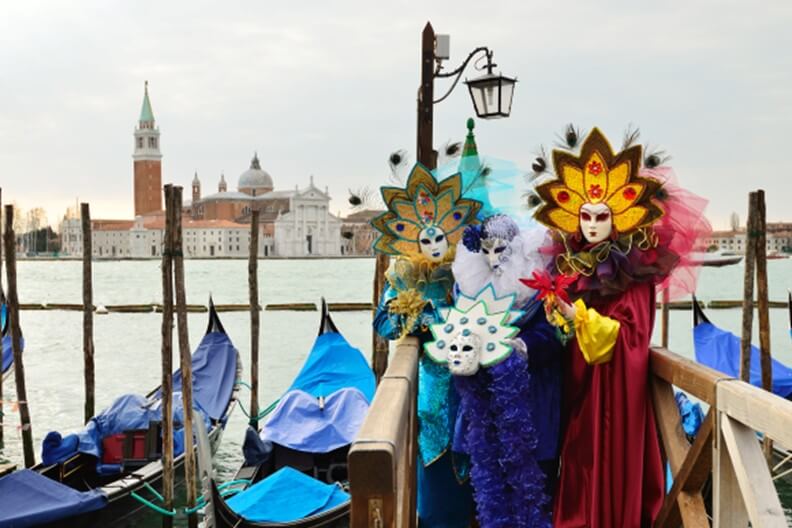These days, most people have traveled to different places in the world – or, at the very least, they know people who have. This travel might be within the United States or to different countries. With the world growing more global in nature, people can see different cultures and different parts of the world through videos, pictures, and blogs. However, nothing is quite the same as a firsthand, unique and memorable experience to an actual destination.
Group incentive travel cultivates experiences that stand a good chance of appealing to everyone in the group, in addition to making these experiences stand out from their other travels. A successful approach to group incentive travel hinges largely on incorporating the local culture of the destination into each activity and outing. Why is this approach a smart one? A recent survey of 2,301 American adults conducted by MMGY Global Travel Intelligence underscored the strong connection drawn between travel and local culture. (1)
- 53% of respondents consider cultural immersion essential to travel.
- Six in 10 respondents feel it is vital to learn about the culture of the destinations they visit.
- 48% of respondents want to spend time with locals during their travels.
Therefore, the following are four effective ways to enhance group incentive travel with authentic cultural experiences.
1. TAKE A HOLISTIC APPROACH TO THE DESTINATION
A good travel planner will let the destination do the heavy lifting. In other words, the destination will offer the cultural aspects, activities, entertainment options, sights, and sounds necessary to achieve the objectives of the trip.
For example, a group incentive travel to New Orleans might include a meal where travelers can peel their own crawfish, a jazz music-infused neighborhood second-line celebration where everyone is welcome to join, and a guided tour through the Arts & Warehouse District. These activities are all culturally significant to New Orleans, and they offer travelers an authentic glimpse into the daily lives of the city’s inhabitants.
A holistic approach is critical because it allows you to create a well-rounded experience that appeals to different interests and immerses participants in the best of what that destination has to offer.
2. GET WELL-VERSED IN THE CULTURE
A key part of fully experiencing the culture of a destination is learning about it. True immersion goes beyond a few hastily thrown-together tidbits. It involves learning about different aspects of the culture, such as local customs, etiquette, and gestures. In fact, you might consider creating a cultural advice booklet and making it available electronically so your participants can access it via a mobile device or tablet throughout their stay.
Information should address the following:
- Proper attire, including any dress codes that apply – examples could include skirt length, areas of the body that must be covered, and whether form-fitting clothing is acceptable.
- Behavior that is considered polite and behavior that is considered rude – examples could include demonstrating appreciation and gratitude, refusing food and drinks, waving, pointing, yawning, and making the “ok” hand gesture.
- How to interact the first time they meet someone – examples could include shaking hands, kissing on the cheeks, hugging and making eye contact.
- How to properly use electronics – examples could include when and where it is ok to take photographs and record videos.
- Acceptable behavior to exhibit while dining – examples could include how much to tip servers, finishing all the food on their plate, whether it is ok to give leftover food to pets or other animals, how to use utensils, and whether the meal should be served family style or via a buffet setup.
- What kinds of items are not viewed as acceptable souvenirs – examples could include sacred religious objects, plants growing in the wild, animals, and items that contain fur or feathers.
Learning the lingo used in a place is fun and could even prove helpful to your employees. That said, it is important for them to avoid using words or phrases incorrectly. But if you provide them with a guide that contains a few commonly used expressions, they should be in good shape.
Examples of lingo in places around the world include:
- Sweden – “There is no cow on the ice” means there is no reason to panic. (2)
- Portugal – “Do not feed the donkey sponge cake” means do not give special treatment to someone who does not deserve it. (3)
- Spain – “Give someone a pumpkin” means that person was rejected. (3)
- Ireland – “Up to 90” means a day was very busy or chaotic. (4)
- Germany – “A cat’s jump” means something or someone is only a short distance away. (3)
- Sicily, Italy – “They lick the sardine” means that person is cruel. (5)
- Iowa, United States – “Padiddle” is used to call out a car that has a missing taillight. (6)
- Minnesota, United States – “Uff da” is used to express emotions like dismay, surprise, frustration and exhaustion. (6)
3. SHOW SUPPORT FOR THE LOCAL COMMUNITY AND CULTURE
While you want your employers to enjoy their trip, you have a responsibility to educate them on how they can support the community(ies) in which they will be spending time. It is integral to being a considerate, respectful, and ethical traveler. The good news is there are plenty of ways to show support.
Culinary Experiences
In many cultures, preparing and enjoying a meal together are viewed as rites of passage. Traditions are sacred and get passed down by each generation. The best way to learn about the cuisine and traditions is to dine with the locals.
“Dine with” is the key phrase here. This entails sitting down with the locals and sharing the meal with them, not just having locals serve participants. The locals can talk about traditional cuisine, as well as their customs and the history behind them. If the destination is in a country where English is not one of the languages spoken, hire a translator (or several, if the group is large) to overcome the language barrier.
Cultural Activities
There is a wealth of ways in which participants can have authentic cultural experiences. By seizing these opportunities and providing variety, you will position employees to benefit from an unforgettable and unique trip.
Cultural activities that are great for leaving a lasting impression and preserving beloved traditions include:
- Taking an art class.
- Watching a dance performance.
- Participating in outdoor activities like glacier hiking, a safari tour, and kayaking.
- Speaking with the locals to learn information about the destination, things that locals do or places they recommend as part of their cultural experience or favorite places to dine that cannot be found online or in travel books or publications.
- Venturing outside the city limits to quaint villages in the countryside to get a firsthand look at the landscape and lifestyle there.
- Taking public transit like trains, buses, and ferries to experience an aspect of daily life as the locals do.
- Attending events and festivals that celebrate the culture and traditions of the area.
Traditional Dress
While some of it might be quite stylish, donning garments that adhere to the traditional dress of the culture is much deeper than fashion. For many cultures, it is a proud representation of their history, trials and tribulations as well as triumphs. On a different note, there is often a functional aspect of the way locals dress, meaning that it helps them attain comfort in extreme temperatures.
Hire a local to educate participants on the trip about the area’s traditional dress. This way, they can learn the reasons why certain colors, patterns, fabrics, and accessories are worn. And if participants wish to join the locals in traditional dress, they can do so respectfully. Educated participants will know what is respectfully appropriate to wear and how to wear it to avoid traditional dress coming off as a costume or culturally appropriated attire.
Guided Tours
The best tour guides are locals who are deeply ingrained and invested in the community. They have the inside knowledge to share insight with participants that outsiders often lack. Examples of tours that are ideal include:
- Museums for history, artifacts, sculptures, paintings, and innovations.
- Architecture on structures like religious centers, historical monuments, and homes of well-known people.
- Performing arts like dancing, operas, orchestra performances, comedy shows, plays, and poetry readings.
- Markets with food and crafts made and sold by local artisans.
- Areas with vibrant nightlife have aspects unique to the area.
- Gardens with a design and plants that have special meaning to the local culture.
4. BE THOUGHTFUL ABOUT CULTURAL TRADITIONS
Respect for local traditions should carry over to conversations with local vendors. Demonstrate a genuine interest in the culture when speaking with them. And seek out their predilections on cultural matters.
Questions that are a good fit for this line of thought include:
- In an ideal world, what would you want visitors to learn about your culture?
- How has history impacted your culture, your business, and the workings of your community?
- What tradition or symbol is most recognizable in your culture? Will you please elaborate on it?
- What are the most beloved holidays or occasions that your community celebrates? Why are they so beloved? Can outsiders participate in them, or are they exclusive to locals?
This raises another valid point. You should use local suppliers as often as possible. Doing so is another form of respect. Plus, it will be educational for your team and the travelers going on the trip. Viable ways to incorporate local suppliers include using items from local artisans in welcome baskets and setting up meals that feature farm-to-table menu items. When booking suppliers, conduct research to verify that the values of their company align with the values of your organization.
If the opportunity to host an exhibition featuring local craftsmen and artisans exists, seize it. This type of event offers the chance to educate employees while demonstrating respect and deference to the community and culture.
Speaking of events, it is crucial to plan around any cultural events that might be taking place while your participants are in town. Otherwise, your organization might be perceived as being apathetic toward the local culture.
PRO TIP:
When incorporating local culture into group incentive travel, it is imperative to avoid creating misunderstandings and promoting stereotypes. Without research and preparation, even the best of intentions can lead to damaging missteps. Carefully consider the following when planning culturally immersive travel:
- How will this activity honor and/or preserve the local culture?
- Have we taken precautions to ensure that this activity will not harm the community?
- Are we making efforts to engage with locals to minimize stereotypes?
- Are we sharing the true meaning or the symbolism behind cultural aspects like food, artwork, dance, music, and festivals with participants so they better understand the rich history of the local culture?
- Do we have permission from locals or residents to see artisans at work, involve participants in activities, or join in local traditions?
- Have we given credit or compensation where it might be applicable, even if it has not been requested?
- How will we show appreciation to the local community for their generosity?
CULTURAL INSPIRATION AND RESPECT CREATE MUTUALLY BENEFICIAL TRAVEL EXPERIENCES
When group incentive travel is planned with all of the above considerations taken into account, the outcome benefits your organization, the participants who go on the trip, and the local community that lives in the destination.
Remember, showing respect for the locals and their culture is essential. This point cannot be overstated. Think about how people in your community would want visitors to treat them. Chances are, demonstrating respect would go a long way.
Education and research are the tenets of travel plans that adhere to the tenets of responsible, ethical travel plans. They inform both the team making the plans and the participants visiting the destination.
Going to these lengths requires a bit more work upfront, but it will be well worth it in the long term. It will spark engagement in participants and stoke the fire of their enthusiasm for incentives.
Travel incentives are a powerful way to motivate teams to improve morale and keep employees engaged in company objectives. Contact Gavel International to learn more.
_______________________
SOURCES
1 https://www.travelmarketreport.com/News/articles/Americans-Want-More-Culturally-Immersive-Vacations-MMGY-Study-Says
2 https://www.wanderlust.co.uk/content/14-strange-phrases/
3 https://viralscape.com/idioms-around-the-world/
4 https://www.theirishroadtrip.com/irish-slang-words/
5 https://thetravelyogi.com/blog/phrases-sicilian/
6 https://www.thedailymeal.com/travel/funniest-slang-term-every-state-slideshow
This article was last updated on April 12, 2023
- 5 Ways to Build a Productive and Participatory Meeting Culture - March 31, 2025
- Build a Culture of Curiosity and Solutions-Driven Change - March 17, 2025
- Gavel International Celebrates GMID 2025 - March 14, 2025






